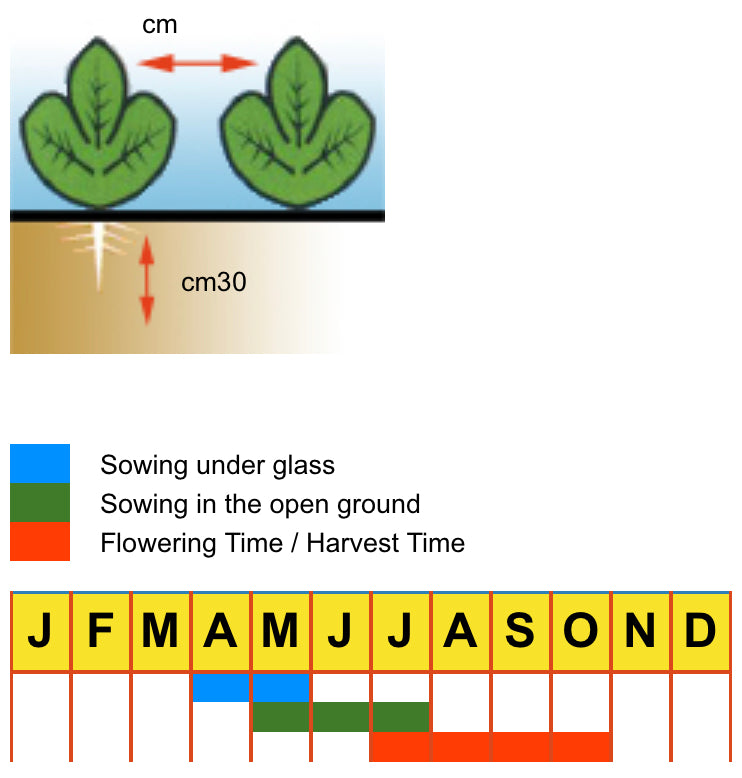1
/
of
2
Leaf celery Green Sleeves
Leaf celery Green Sleeves
Regular price
1.350 KWD
Regular price
Sale price
1.350 KWD
Unit price
/
per
Shipping calculated at checkout.
Couldn't load pickup availability
Growing Leaf Celery “Green Sleeves” is a relatively straightforward process. Here’s a guide to help you cultivate this variety successfully:
1. Planting Time: Start seeds indoors 8-10 weeks before the last expected frost, or direct sow them outdoors after the last frost date. Leaf celery can also be grown as a fall crop by planting seeds in late summer.
2. Site Selection: Choose a location with partial shade to full sun. Leaf celery prefers cooler temperatures, making it suitable for both spring and fall plantings.
3. Soil Preparation: Ensure the soil is well-draining and rich in organic matter. Incorporate compost or well-rotted manure to enhance soil fertility. Leaf celery thrives in slightly acidic to neutral soil with a pH between 6.0 and 7.0.
4. Planting Seeds: Sow Leaf Celery “Green Sleeves” seeds about 1/4 inch deep. Space the seeds according to the recommended spacing on the seed packet.
5. Watering: Keep the soil consistently moist, especially during dry periods. Celery requires regular watering to maintain even moisture levels. Avoid waterlogging the soil.
6. Thinning: If you started with seeds, thin the seedlings once they are a few inches tall to ensure proper spacing. This allows the leaf celery to develop well.
7. Fertilization: Apply a balanced fertilizer at planting time and consider side-dressing with additional fertilizer during the growing season. Celery benefits from consistent nutrients.
8. Mulching: Apply a layer of organic mulch around the Leaf Celery plants to retain soil moisture, suppress weeds, and regulate soil temperature.
9. Harvesting: Harvest Leaf Celery “Green Sleeves” by cutting individual leaves or harvesting the entire plant at ground level. Harvesting can begin when the leaves are of sufficient size, usually around 60-70 days after planting.
10. Successive Planting: For a continuous harvest, consider successive plantings every few weeks.
11. Pest and Disease Control: Keep an eye out for common celery pests such as aphids or celery worms. Insecticidal soap or neem oil can be used for organic pest control. Practice good garden hygiene to minimize disease issues.
12. Storage: Use harvested Leaf Celery promptly for the best flavor and texture. If you have excess, you can store it in the refrigerator for a short period.
Growing Leaf Celery “Green Sleeves” can add a fresh and aromatic element to your garden. Enjoy cultivating this variety in your home garden!
1. Planting Time: Start seeds indoors 8-10 weeks before the last expected frost, or direct sow them outdoors after the last frost date. Leaf celery can also be grown as a fall crop by planting seeds in late summer.
2. Site Selection: Choose a location with partial shade to full sun. Leaf celery prefers cooler temperatures, making it suitable for both spring and fall plantings.
3. Soil Preparation: Ensure the soil is well-draining and rich in organic matter. Incorporate compost or well-rotted manure to enhance soil fertility. Leaf celery thrives in slightly acidic to neutral soil with a pH between 6.0 and 7.0.
4. Planting Seeds: Sow Leaf Celery “Green Sleeves” seeds about 1/4 inch deep. Space the seeds according to the recommended spacing on the seed packet.
5. Watering: Keep the soil consistently moist, especially during dry periods. Celery requires regular watering to maintain even moisture levels. Avoid waterlogging the soil.
6. Thinning: If you started with seeds, thin the seedlings once they are a few inches tall to ensure proper spacing. This allows the leaf celery to develop well.
7. Fertilization: Apply a balanced fertilizer at planting time and consider side-dressing with additional fertilizer during the growing season. Celery benefits from consistent nutrients.
8. Mulching: Apply a layer of organic mulch around the Leaf Celery plants to retain soil moisture, suppress weeds, and regulate soil temperature.
9. Harvesting: Harvest Leaf Celery “Green Sleeves” by cutting individual leaves or harvesting the entire plant at ground level. Harvesting can begin when the leaves are of sufficient size, usually around 60-70 days after planting.
10. Successive Planting: For a continuous harvest, consider successive plantings every few weeks.
11. Pest and Disease Control: Keep an eye out for common celery pests such as aphids or celery worms. Insecticidal soap or neem oil can be used for organic pest control. Practice good garden hygiene to minimize disease issues.
12. Storage: Use harvested Leaf Celery promptly for the best flavor and texture. If you have excess, you can store it in the refrigerator for a short period.
Growing Leaf Celery “Green Sleeves” can add a fresh and aromatic element to your garden. Enjoy cultivating this variety in your home garden!
Share



